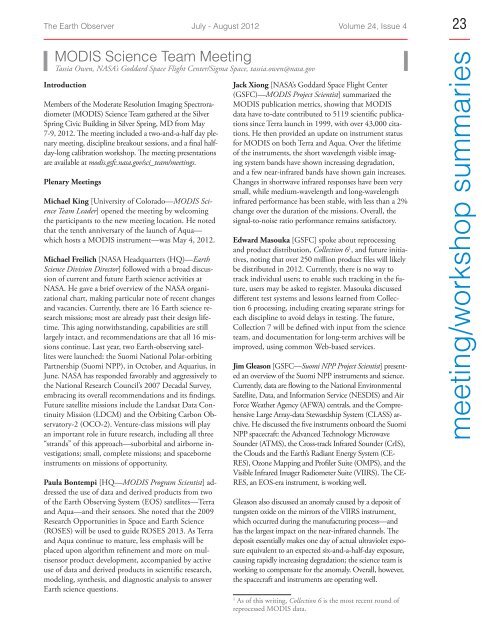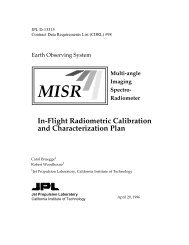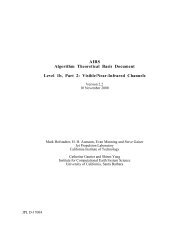Download - NASA's Earth Observing System
Download - NASA's Earth Observing System
Download - NASA's Earth Observing System
You also want an ePaper? Increase the reach of your titles
YUMPU automatically turns print PDFs into web optimized ePapers that Google loves.
The <strong>Earth</strong> Observer July - August 2012 Volume 24, Issue 4 23<br />
MODIS Science Team Meeting<br />
Tassia Owen, NASA’s Goddard Space Flight Center/Sigma Space, tassia.owen@nasa.gov<br />
Introduction<br />
Members of the Moderate Resolution Imaging Spectroradiometer<br />
(MODIS) Science Team gathered at the Silver<br />
Spring Civic Building in Silver Spring, MD from May<br />
7-9, 2012. The meeting included a two-and-a-half day plenary<br />
meeting, discipline breakout sessions, and a final halfday-long<br />
calibration workshop. The meeting presentations<br />
are available at modis.gsfc.nasa.gov/sci_team/meetings.<br />
Plenary Meetings<br />
Michael King [University of Colorado—MODIS Science<br />
Team Leader] opened the meeting by welcoming<br />
the participants to the new meeting location. He noted<br />
that the tenth anniversary of the launch of Aqua—<br />
which hosts a MODIS instrument—was May 4, 2012.<br />
Michael Freilich [NASA Headquarters (HQ)—<strong>Earth</strong><br />
Science Division Director] followed with a broad discussion<br />
of current and future <strong>Earth</strong> science activities at<br />
NASA. He gave a brief overview of the NASA organizational<br />
chart, making particular note of recent changes<br />
and vacancies. Currently, there are 16 <strong>Earth</strong> science research<br />
missions; most are already past their design lifetime.<br />
This aging notwithstanding, capabilities are still<br />
largely intact, and recommendations are that all 16 missions<br />
continue. Last year, two <strong>Earth</strong>-observing satellites<br />
were launched: the Suomi National Polar-orbiting<br />
Partnership (Suomi NPP), in October, and Aquarius, in<br />
June. NASA has responded favorably and aggressively to<br />
the National Research Council’s 2007 Decadal Survey,<br />
embracing its overall recommendations and its findings.<br />
Future satellite missions include the Landsat Data Continuity<br />
Mission (LDCM) and the Orbiting Carbon Observatory-2<br />
(OCO-2). Venture-class missions will play<br />
an important role in future research, including all three<br />
“strands” of this approach—suborbital and airborne investigations;<br />
small, complete missions; and spaceborne<br />
instruments on missions of opportunity.<br />
Paula Bontempi [HQ—MODIS Program Scientist] addressed<br />
the use of data and derived products from two<br />
of the <strong>Earth</strong> <strong>Observing</strong> <strong>System</strong> (EOS) satellites—Terra<br />
and Aqua—and their sensors. She noted that the 2009<br />
Research Opportunities in Space and <strong>Earth</strong> Science<br />
(ROSES) will be used to guide ROSES 2013. As Terra<br />
and Aqua continue to mature, less emphasis will be<br />
placed upon algorithm refinement and more on multisensor<br />
product development, accompanied by active<br />
use of data and derived products in scientific research,<br />
modeling, synthesis, and diagnostic analysis to answer<br />
<strong>Earth</strong> science questions.<br />
Jack Xiong [NASA’s Goddard Space Flight Center<br />
(GSFC)—MODIS Project Scientist] summarized the<br />
MODIS publication metrics, showing that MODIS<br />
data have to-date contributed to 5119 scientific publications<br />
since Terra launch in 1999, with over 43,000 citations.<br />
He then provided an update on instrument status<br />
for MODIS on both Terra and Aqua. Over the lifetime<br />
of the instruments, the short wavelength visible imaging<br />
system bands have shown increasing degradation,<br />
and a few near-infrared bands have shown gain increases.<br />
Changes in shortwave infrared responses have been very<br />
small, while medium-wavelength and long-wavelength<br />
infrared performance has been stable, with less than a 2%<br />
change over the duration of the missions. Overall, the<br />
signal-to-noise ratio performance remains satisfactory.<br />
Edward Masouka [GSFC] spoke about reprocessing<br />
and product distribution, Collection 6 1 , and future initiatives,<br />
noting that over 250 million product files will likely<br />
be distributed in 2012. Currently, there is no way to<br />
track individual users; to enable such tracking in the future,<br />
users may be asked to register. Masouka discussed<br />
different test systems and lessons learned from Collection<br />
6 processing, including creating separate strings for<br />
each discipline to avoid delays in testing. The future,<br />
Collection 7 will be defined with input from the science<br />
team, and documentation for long-term archives will be<br />
improved, using common Web-based services.<br />
Jim Gleason [GSFC—Suomi NPP Project Scientist] presented<br />
an overview of the Suomi NPP instruments and science.<br />
Currently, data are flowing to the National Environmental<br />
Satellite, Data, and Information Service (NESDIS) and Air<br />
Force Weather Agency (AFWA) centrals, and the Comprehensive<br />
Large Array-data Stewardship <strong>System</strong> (CLASS) archive.<br />
He discussed the five instruments onboard the Suomi<br />
NPP spacecraft: the Advanced Technology Microwave<br />
Sounder (ATMS), the Cross-track Infrared Sounder (CrIS),<br />
the Clouds and the <strong>Earth</strong>’s Radiant Energy <strong>System</strong> (CE-<br />
RES), Ozone Mapping and Profiler Suite (OMPS), and the<br />
Visible Infrared Imager Radiometer Suite (VIIRS). The CE-<br />
RES, an EOS-era instrument, is working well.<br />
Gleason also discussed an anomaly caused by a deposit of<br />
tungsten oxide on the mirrors of the VIIRS instrument,<br />
which occurred during the manufacturing process—and<br />
has the largest impact on the near-infrared channels. The<br />
deposit essentially makes one day of actual ultraviolet exposure<br />
equivalent to an expected six-and-a-half-day exposure,<br />
causing rapidly increasing degradation; the science team is<br />
working to compensate for the anomaly. Overall, however,<br />
the spacecraft and instruments are operating well.<br />
1<br />
As of this writing, Collection 6 is the most recent round of<br />
reprocessed MODIS data.<br />
meeting/workshop summaries







